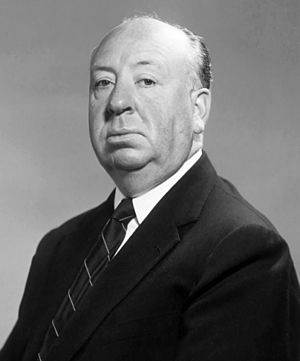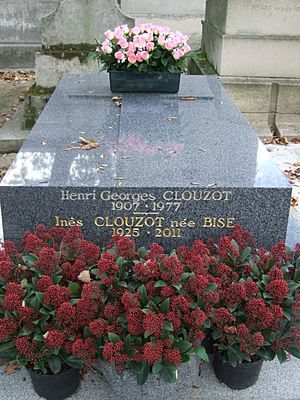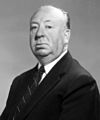Henri-Georges Clouzot facts for kids
Quick facts for kids
Henri-Georges Clouzot
|
|
|---|---|

Henri-Georges Clouzot in 1953
|
|
| Born | 20 November 1907 Niort, France
|
| Died | 12 January 1977 (aged 69) Paris, France
|
| Occupation | Film director screenwriter film producer |
| Years active | 1931–1968 |
| Spouse(s) |
Véra Gibson-Amado
(m. 1950; died 1960)Inès de Gonzalez
(m. 1963–1977) |
Henri-Georges Clouzot (French: [ɑ̃ʁi ʒɔʁʒ kluzo]; born November 20, 1907 – died January 12, 1977) was a famous French film director, writer, and producer. He is best known for his exciting thriller movies like The Wages of Fear (1953) and Les Diaboliques (1955). Many people consider these films to be among the best of the 1950s.
Clouzot also made documentary films, such as The Mystery of Picasso (1956). The French government even called this film a national treasure. He is one of only three directors whose films have won top awards at the Berlin, Venice, and Cannes film festivals.
Clouzot loved movies from a young age and wanted to be a writer. He moved to Paris and later worked in Berlin, writing French versions of German films. After facing difficulties in Germany, he returned to France. He became very ill with tuberculosis and spent years recovering.
When he got better, he worked as a screenwriter for a German-owned film company during World War II. His films became very popular. However, one of his films, Le Corbeau, caused a lot of debate. Because of his work during the war, the French government stopped him from making films until 1947.
After the ban was lifted, Clouzot became popular again with successful films like Quai des Orfèvres. He married Véra Gibson-Amado, who starred in his next three movies. In the 1950s, his films The Wages of Fear and Les Diaboliques became famous around the world.
After his wife Véra passed away, Clouzot's career slowed down due to sadness and health issues. New film styles like the French New Wave also changed how critics saw his work. He made fewer films in his later years, mostly television documentaries and two feature films in the 1960s. He died in Paris in 1977.
Contents
Early Life and Career Beginnings
Growing Up in France
Henri-Georges Clouzot was born in Niort, France, on November 20, 1907. His father, Georges Clouzout, owned a bookstore. Henri-Georges was the oldest of three children in a middle-class family. He showed early talent in writing plays and playing the piano.
In 1922, his father's bookstore closed, and the family moved to Brest. There, Henri-Georges went to Naval School. However, he couldn't become a Naval Cadet because he had myopia, which means he couldn't see far away very well.
Moving to Paris and Berlin
At 18, Clouzot moved to Paris to study political science. In Paris, he made friends with magazine editors. His writing skills led him to work in theater and cinema, writing plays and film scripts.
A film producer named Adolphe Osso hired him. Clouzot was sent to Berlin, Germany, to translate scripts for foreign films being made there.
Becoming a Filmmaker
Screenwriting Years (1931–1942)
Throughout the 1930s, Clouzot wrote and translated scripts for more than twenty films. While living in Germany, he was greatly inspired by the films of F. W. Murnau and Fritz Lang. Their movies had a special style called German Expressionism, which used shadows and strong lighting.
Clouzot made his first short film, La Terreur des Batignolles, in 1931. It was a 15-minute comedy. Film experts later said this short film was "surprisingly well made" and used shadows and light in a way Clouzot would use in his later, longer movies.
In 1934, Clouzot lost his job at UFA Studios. This happened because he was friends with Jewish film producers.
Illness and War Years
In 1935, Clouzot became very sick with tuberculosis. He had to stay in bed for almost five years in a special hospital called a sanatorium in Switzerland. This time greatly affected his career. While sick, Clouzot read a lot and learned how to write better stories. He also studied the people around him in the sanatorium.
When Clouzot returned to Paris, World War II had started. Many film producers he knew had left France to escape the war. Clouzot's health problems meant he couldn't join the military.
During the war, a German-run film company called Continental Films was set up in France. The director of Continental knew Clouzot from Berlin and offered him work. Clouzot needed money badly, so he accepted. His first film for Continental was Le Dernier des six, a mystery movie.
Early Directing Work (1942–1947)
After Le Dernier de six was successful, Clouzot became the head of Continental's screenwriting team. He then directed his second film, The Murderer Lives at Number 21, which was also popular.
Clouzot's next film was Le Corbeau (The Raven). It was based on a true story about someone sending mean, anonymous letters. This film caused a lot of discussion. Some people thought it showed the French people in a bad light. Two days before the film was released, Clouzot was fired.
After France was freed from German occupation, Clouzot and other directors were questioned about working with the Germans. Clouzot was banned from making films for a time. Many famous artists and filmmakers, like Jean Cocteau and Jean-Paul Sartre, supported him. His ban was later shortened to two years. During this time, he worked with Jean-Paul Sartre.
International Acclaim
Return to Filmmaking (1947–1960)
Once his ban was lifted, Clouzot quickly became popular again in the late 1940s with films like Quai des Orfèvres and Manon. Quai des Orfèvres was the fourth most popular film in France in 1947.
For Manon, Clouzot wanted to use new actors. He found 17-year-old Cécile Aubry for the main role after looking at over 700 girls. Manon won a top award at the Venice Film Festival.
Clouzot's next film, the comedy Miquette et Sa Mère, did not do well financially. During its making, he met Véra Gibson-Amado. They married on January 15, 1950.
Clouzot and Véra went to Brazil for their honeymoon and tried to make a documentary about the country. However, the Brazilian government didn't like that Clouzot was filming poor areas instead of beautiful ones. The film was never finished.

Back in France, Clouzot was offered a script about experiences in South America. He started writing the film, The Wages of Fear, with his brother. To have more control, Clouzot started his own film company, Véra Films, named after his wife. Véra also played the only female role in The Wages of Fear.
The Wages of Fear is about desperate men who drive trucks carrying dangerous explosives to put out an oil well fire. It was a huge success in France and won awards at the Cannes Film Festival.
Clouzot's next big hit was Les Diaboliques. He got the rights to this story before director Alfred Hitchcock could. In 1954, Les Diaboliques won important awards. Both The Wages of Fear and Les Diaboliques made Clouzot famous worldwide. They are still considered some of the best thrillers of that time.
In 1955, Clouzot directed the documentary The Mystery of Picasso, about the Spanish painter Pablo Picasso. The film shows Picasso drawing and painting. All the artworks made for the film were destroyed afterward. The Mystery of Picasso won an award at the Cannes Film Festival. In 1984, France declared it a national treasure.
Clouzot's next film was Les Espions (The Spies), released in 1957. It was the last acting role for his wife, Véra, who had heart problems. Les Espions was not a financial success.
Producer Raoul Levy suggested Clouzot's next film should star Brigitte Bardot. Clouzot wrote the script for La Vérité (The Truth). Bardot later said it was her favorite film to work on. Released in 1960, La Vérité was very popular in France and was nominated for an Academy Award for Best Foreign Language Film.
Later Career and Health Challenges (1960–1977)
Facing New Criticisms
Even though Clouzot was famous internationally, his reputation in French cinema changed with the rise of the French New Wave. These new directors often criticized his thriller films. Clouzot took their comments seriously.
His next film, L'Enfer (Inferno), was never finished. The main actor became ill, and then Clouzot himself got sick during filming. Doctors and insurance companies stopped the production.
Between 1965 and 1967, Clouzot made five documentaries for French television. These films showed famous conductor Herbert von Karajan leading classical music performances.
Final Film and Passing
After making the documentaries, Clouzot was able to get money for his last feature film, La Prisonnière. Production started in September 1967 but stopped when Clouzot became ill again. He was in the hospital until April 1968 and started filming again in August 1968.
After finishing La Prisonnière, Clouzot's health worsened. In the 1970s, he wrote a few more scripts but never filmed them.
Death and Legacy
Clouzot's health continued to decline. He had open-heart surgery in November 1976. On January 12, 1977, Clouzot passed away in his apartment in Paris while listening to music. He is buried next to his first wife, Véra, in the Montmartre Cemetery.
Personal Connections
In the late 1930s, Clouzot met actress Suzy Delair. They were a couple for 12 years, and Delair starred in two of his films, The Murderer Lives at Number 21 and Quai des Orfèvres.
Clouzot met his first wife, Véra Clouzot, while she was working on his film Miquette et Sa Mère. He named his film company after Véra, and she starred in all three films made by the company: The Wages of Fear, Diabolique, and Les Espions. Véra also helped write the script for La Vérité. Véra Clouzot passed away from a heart attack shortly after La Vérité was filmed. Clouzot was very sad after her death.
Clouzot met his second wife, Inès de Gonzalez, in 1962. They married in December 1963. In the 1960s, Clouzot became a Catholic.
His Lasting Impact
Even with some criticism from the French New Wave, Clouzot's films are still highly regarded today. Film experts often compare his thriller movies to those of Alfred Hitchcock. Clouzot admired Hitchcock's work and felt honored by the comparisons.
Several of Clouzot's films have been remade:
- Le Corbeau was remade as The 13th Letter in 1951.
- The Wages of Fear was remade as Sorcerer in 1977.
- Clouzot's unfinished script for L'Enfer was used for a film also called L'Enfer in 1994.
- Les Diaboliques was remade in America as Diabolique in 1996, starring Sharon Stone.
Key Films Directed by Clouzot
- L'assassin habite... au 21 (The Murderer Lives at Number 21, 1942)
- Le corbeau (The Raven, 1943)
- Quai des orfèvres (Goldsmiths' Quay, 1947)
- Manon (1949)
- Miquette et sa mère (Miquette, 1950)
- Le salaire de la peur (The Wages of Fear, 1953)
- Les diaboliques (Diabolique, 1955)
- Le mystère Picasso (The Mystery of Picasso, 1956)
- Les espions (The Spies, 1957)
- La vérité (The Truth, 1960)
- La prisonnière (Woman in Chains, 1968)
Images for kids
See also
 In Spanish: Henri-Georges Clouzot para niños
In Spanish: Henri-Georges Clouzot para niños





